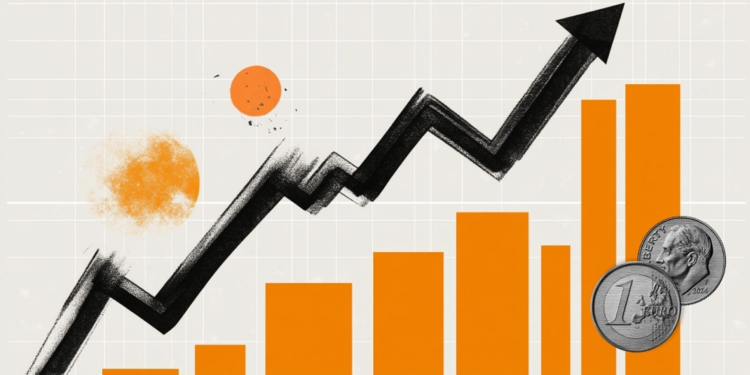- EUR/USD trades in positive territory above 1.1450 in the early American session.
- Annual CPI inflation in the US rose to 2.4% in May.
- The US Dollar struggles to stay resilient against its rivals.
EUR/USD gained traction and advanced toward 1.1500 in the early American session on Wednesday. The pair was last seen trading at 1.1465, rising 0.35% on a daily basis.
Euro PRICE Today
The table below shows the percentage change of Euro (EUR) against listed major currencies today. Euro was the strongest against the New Zealand Dollar.
| USD | EUR | GBP | JPY | CAD | AUD | NZD | CHF | |
|---|---|---|---|---|---|---|---|---|
| USD | -0.30% | -0.11% | -0.09% | -0.02% | 0.04% | 0.16% | -0.24% | |
| EUR | 0.30% | 0.18% | 0.20% | 0.25% | 0.32% | 0.40% | 0.04% | |
| GBP | 0.11% | -0.18% | 0.02% | 0.11% | 0.16% | 0.23% | -0.15% | |
| JPY | 0.09% | -0.20% | -0.02% | -0.04% | 0.14% | 0.22% | -0.18% | |
| CAD | 0.02% | -0.25% | -0.11% | 0.04% | 0.09% | 0.15% | -0.25% | |
| AUD | -0.04% | -0.32% | -0.16% | -0.14% | -0.09% | 0.08% | -0.29% | |
| NZD | -0.16% | -0.40% | -0.23% | -0.22% | -0.15% | -0.08% | -0.38% | |
| CHF | 0.24% | -0.04% | 0.15% | 0.18% | 0.25% | 0.29% | 0.38% |
The heat map shows percentage changes of major currencies against each other. The base currency is picked from the left column, while the quote currency is picked from the top row. For example, if you pick the Euro from the left column and move along the horizontal line to the US Dollar, the percentage change displayed in the box will represent EUR (base)/USD (quote).
USD weakens after softer-than-expected inflation data
The US Dollar (USD) weakened against its rivals with the immediate reaction to May inflation data from the US and helped EUR/USD push higher midweek.
The US Bureau of Labor Statistics reported that the Consumer Price Index (CPI) and the core CPI both rose 0.1% in May, at a softer pace than analysts’ estimates. On a yearly basis, the CPI rose 2.4% following the 2.3% increase recorded in April and this figure came in below the market expectation of 2.5%. In this period, the core CPI increased 2.8% to match the April print.
Reflecting the negative impact of inflation data, the US Dollar Index loses about 0.3% on the day below 99.00.
Meanwhile, US President Donald Trump shared some details regarding the US-China trade agreement. This development, however, failed to help the USD gather strength.
“Full magnets, and any necessary rare earths, will be supplied, up front, by China. Likewise, we will provide to China what was agreed to, including Chinese students using our colleges and universities (which has always been good with me!),” Trump said on Truth Social. “We are getting a total of 55% tariffs, China is getting 10%. Relationship is excellent!”
The economic calendar will not feature any other high-impact data releases on Wednesday. Nevertheless, the outcome of the 10-year Treasury note auction could impact the USD’s valuation later in the American session.
Inflation FAQs
Inflation measures the rise in the price of a representative basket of goods and services. Headline inflation is usually expressed as a percentage change on a month-on-month (MoM) and year-on-year (YoY) basis. Core inflation excludes more volatile elements such as food and fuel which can fluctuate because of geopolitical and seasonal factors. Core inflation is the figure economists focus on and is the level targeted by central banks, which are mandated to keep inflation at a manageable level, usually around 2%.
The Consumer Price Index (CPI) measures the change in prices of a basket of goods and services over a period of time. It is usually expressed as a percentage change on a month-on-month (MoM) and year-on-year (YoY) basis. Core CPI is the figure targeted by central banks as it excludes volatile food and fuel inputs. When Core CPI rises above 2% it usually results in higher interest rates and vice versa when it falls below 2%. Since higher interest rates are positive for a currency, higher inflation usually results in a stronger currency. The opposite is true when inflation falls.
Although it may seem counter-intuitive, high inflation in a country pushes up the value of its currency and vice versa for lower inflation. This is because the central bank will normally raise interest rates to combat the higher inflation, which attract more global capital inflows from investors looking for a lucrative place to park their money.
Formerly, Gold was the asset investors turned to in times of high inflation because it preserved its value, and whilst investors will often still buy Gold for its safe-haven properties in times of extreme market turmoil, this is not the case most of the time. This is because when inflation is high, central banks will put up interest rates to combat it.
Higher interest rates are negative for Gold because they increase the opportunity-cost of holding Gold vis-a-vis an interest-bearing asset or placing the money in a cash deposit account. On the flipside, lower inflation tends to be positive for Gold as it brings interest rates down, making the bright metal a more viable investment alternative.

